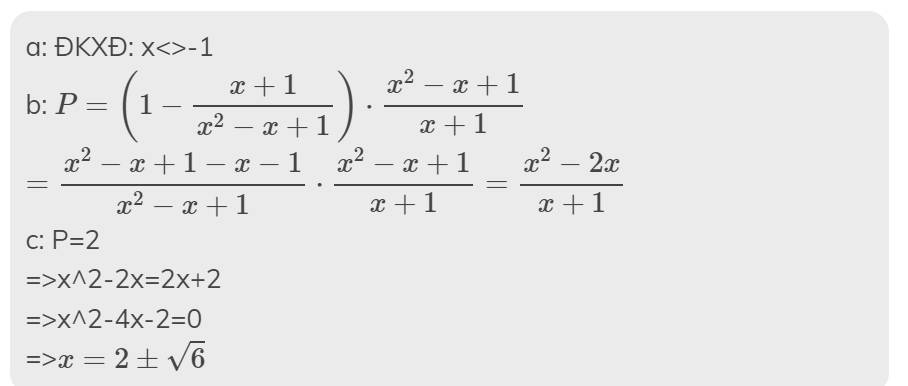Hãy nhập câu hỏi của bạn vào đây, nếu là tài khoản VIP, bạn sẽ được ưu tiên trả lời.

a: ĐKXĐ: \(x\notin\left\{-\dfrac{1}{2};\dfrac{1}{2};-2\right\}\)
b: \(B=\dfrac{4x^2+4x+1-4-4x^2+4x-1}{\left(2x-1\right)\left(2x+1\right)}\cdot\dfrac{2x+1}{x+2}\)
\(=\dfrac{8x-4}{2x-1}\cdot\dfrac{1}{x+2}=\dfrac{4}{x+2}\)

a, ĐKXĐ: x\(\ne\) 1;-1;2
b, A= \(\left(\frac{x}{x+1}+\frac{1}{x-1}-\frac{4x}{2-2x^2}\right):\frac{x+1}{x-2}\)
=\(\left(\frac{2x^2-2x}{2\left(x+1\right)\left(x-1\right)}+\frac{2x+2}{2\left(x+1\right)\left(x-1\right)}+\frac{4x}{2\left(x-1\right)\left(x+1\right)}\right)\times\frac{x-2}{x+1}\)
=\(\frac{2x^2-2x+2x+2+4x}{2\left(x+1\right)\left(x-1\right)}\times\frac{x-2}{x+1}\)
=\(\frac{2x^2+4x+2}{2\left(x+1\right)\left(x-1\right)}\times\frac{x-2}{x+1}\)
=\(\frac{2\left(x+1\right)^2}{2\left(x+1\right)\left(x-1\right)}\times\frac{x-2}{x+1}\)
=\(\frac{x-2}{x-1}\)
c, Khi x= -1
→A= \(\frac{-1-2}{-1-1}\)
= -3
Vậy khi x= -1 thì A= -3
Câu d thì mình đang suy nghĩ nhé, mình sẽ quay lại trả lời sau ^^
a,ĐKXĐ:x#1; x#-1; x#2
b,Ta có:
A=\(\left(\frac{x}{x+1}+\frac{1}{x-1}-\frac{4x}{2-2x^2}\right):\frac{x+1}{x-2}\)
=\(\left(\frac{x\left(x-1\right)2}{\left(x+1\right)\left(x-1\right)2}+\frac{\left(x+1\right)2}{\left(x-1\right)\left(x+1\right)2}+\frac{4x}{2\left(x-1\right)\left(x+1\right)}\right):\frac{x+1}{x-2}\)
=\(\frac{2x^2-2x+2x+2+4x}{\left(x+1\right)\left(x-1\right)2}.\frac{x-2}{x+1}\)
=\(\frac{2x^2+4x+2}{\left(x+1\right)\left(x-1\right)2}.\frac{x-2}{x+1}\)
=\(\frac{2\left(x+1\right)^2}{\left(x+1\right)\left(x-1\right)2}.\frac{x-2}{x+1}\)
=\(\frac{x-2}{x+1}\)
c,Tại x=-1 ,theo ĐKXĐ x#-1 \(\Rightarrow\)A không có kết quả
d,Để A có giá trị nguyên \(\Rightarrow\frac{x-2}{x+1}\)có giá trị nguyên
\(\Leftrightarrow x-2⋮x+1\)
\(\Leftrightarrow x+1-3⋮x+1\)
Mà \(x+1⋮x+1\Rightarrow3⋮x+1\)
\(\Rightarrow x+1\inƯ\left(3\right)=\left\{1;-1;3;-3\right\}\)
\(\Rightarrow x\in\left\{0;-2;2;-4\right\}\)
Mà theo ĐKXĐ x#2\(\Rightarrow x\in\left\{0;-2;-4\right\}\)
Vậy \(x\in\left\{0;-2;-4\right\}\)thì a là số nguyên

a: \(A=\left(\dfrac{x}{x^2-4}+\dfrac{4}{x-2}+\dfrac{1}{x+2}\right):\dfrac{3x+3}{x^2+2x}\)
\(=\dfrac{x+4x+8+x-2}{\left(x-2\right)\left(x+2\right)}\cdot\dfrac{x\left(x+2\right)}{3\left(x+1\right)}\)
\(=\dfrac{6\left(x+1\right)\cdot x\left(x+2\right)}{3\left(x+1\right)\left(x-2\right)\left(x+2\right)}\)
\(=\dfrac{2x}{x-2}\)

a: ĐKXĐ: x<>-1
b: \(P=\left(1-\dfrac{x+1}{x^2-x+1}\right)\cdot\dfrac{x^2-x+1}{x+1}\)
\(=\dfrac{x^2-x+1-x-1}{x^2-x+1}\cdot\dfrac{x^2-x+1}{x+1}=\dfrac{x^2-2x}{x+1}\)
c: P=2
=>x^2-2x=2x+2
=>x^2-4x-2=0
=>\(x=2\pm\sqrt{6}\)

\(P=\left(\frac{2+x}{x^2+2x+1}-\frac{x-2}{x^2-1}\right).\frac{1-x^2}{x}\)
a) ĐKXĐ:
\(\hept{\begin{cases}x^2+2x+1\ne0\\x^2-1\ne0\\x\ne0\end{cases}}\Leftrightarrow\hept{\begin{cases}\left(x+1\right)^2\ne0\\\left(x-1\right)\left(x+1\right)\ne0\\x\ne0\end{cases}\Leftrightarrow\hept{\begin{cases}x+1\ne0\\x\ne1;x\ne-1\\x\ne0\end{cases}}}\)
<=> x khác -1
x khác 1; x khác -1
x khác 0
<=> x khác -1;1;0
Vậy ĐKXĐ là x khác -1;1;0
b) \(P=\left(\frac{2+x}{x^2+2x+1}-\frac{x-2}{x^2-1}\right).\frac{1-x^2}{x}\)
\(\Rightarrow P=\left(\frac{2+x}{\left(x+1\right)^2_{x-1}}-\frac{x-2}{\left(x-1\right)\left(x+1\right)_{x+1}}\right).\frac{1-x}{x}\)
MTC: (x+1)^2(x-1)
\(\Rightarrow P=\left(\frac{\left(2+x\right)\left(x-1\right)}{\left(x+1\right)^2\left(x-1\right)}-\frac{\left(x-2\right)\left(x+1\right)}{\left(x+1\right)^2\left(x-1\right)}\right).\frac{1-x}{x}\)
\(\Rightarrow P=\left(\frac{2x-2+x^2-x}{\left(x+1\right)^2\left(x-1\right)}-\frac{x^2+x-2x-2}{\left(x+1\right)^2\left(x-1\right)}\right)\frac{1-x}{x}\)
\(\Rightarrow P=\left(\frac{x-2+x^2-x^2+x+2}{\left(x+1\right)^2\left(x-1\right)}\right).\frac{1-x}{x}\)
\(\Rightarrow P=\frac{2x}{\left(x+1\right)^2\left(x-1\right)}.\frac{1-x}{x}\)
\(\Rightarrow P=\frac{2x}{-\left(1-x\right)\left(x+1\right)^2}.\frac{1-x}{x}\)
\(\Rightarrow P=-\frac{x}{\left(x+1\right)^2}\) (tmđkxđ)
c)
\(P=-\frac{x}{\left(x+1\right)^2}=-\frac{x+1-1}{\left(x+1\right)\left(x+1\right)}=-\frac{x+1}{x+1}-\frac{1}{x+1}=-1-\frac{1}{x+1}\) ( ĐKXĐ là x khác -1;1;0) \(\left(P\in Z\right)\)
\(P\in Z\Leftrightarrow\frac{-1}{x+1}\)
Nên x+1 thuộc Ư(-1)={1;-1)
x+1=1=>x=1-1=0 ( o t/m đk)
x+1=-1=>x=-1-1=-2( (t/m đk)
<=> x thuộc -2 thì gt của BT P là số nguyên
